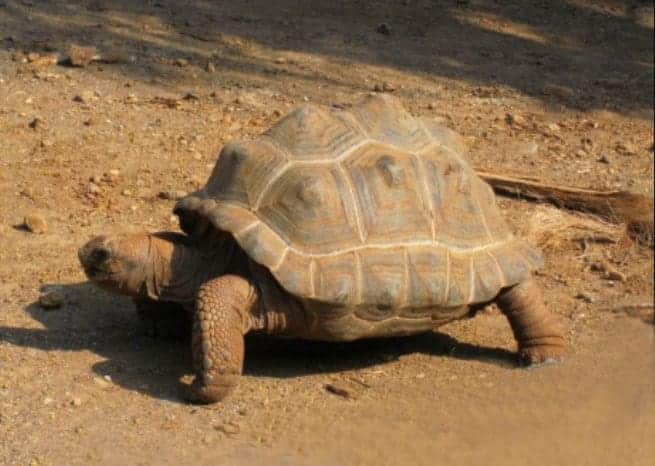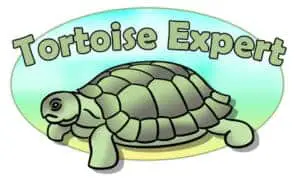
What is Pyramiding?
A tortoise’s shell is made up of a series of polygonal shaped plates known as ‘scutes’. In a normally developing shell the scutes grow in such a way that they form a smooth domed surface across the entire shell. In the case of pyramiding the scutes grow upwards as well, literally forming a series of bumps, or ‘pyramids’.
In addition there seems to be a lot of disagreement over whether pyramiding is in effect the excess growth upwards, in effect caused by an overgrowth of shell, or whether it is actually caused by poor bone and shell growth forming the sunken ‘troughs’ between the pyramids, and forcing the scutes upwards.

Whether you own a tortoise or not, chances are you’ll have seen a tortoise that ‘experiences’ pyramiding (suffering isn’t necessarily the right word, and I’ll come to why later). The reason is because it’s extremely common, especially among tortoises kept in captivity.

That isn’t to say that wild tortoises have a perfect existence of course, when you’ve got predators hunting you and you’re constantly have to forage for food (in dry and barren environments in some cases) it certainly isn’t an easy life.
None the less pyramiding is an often debilitating, yet usually preventable consequence of being in captivity for a tortoise.
What are The Risk Factors?
Although I do for the most part believe that pyramiding is preventable, the truth is that scientists don’t know the precise mechanism for why pyramiding occurs, and why certain tortoises will be more prone to suffering from it than others.
Having said that, there are a number of well documented risk factors that will almost certainly increase a tortoise’s risk of developing a pyramided shell.
Not Getting Those Crucial First Few Years Right
Much of the fastest growth a tortoise will ever do occurs within the first few years of their lives, and it’s believed the way they are raised during this time can have a significant effect on the development of their shell.
More specifically it seems that low humidity, even among mediterranean and desert tortoise species, can be a significant causal factor in the development of pyramiding.
One theory for why this is the case is that the tortoise’s shell grows excessively to try and prevent the loss of water by way of evaporation in an already dry environment.
Whilst I wouldn’t advocate consistent humidity in your tortoise table or vivarium because this can lead to other problems such as shell rot, a few daily sprays from a water bottle over the tortoise, as well as a routine soaking twice a week for 10 minutes and access to drinking and bathing water at all other times are sufficient to meet the needs of most tortoises.
It’s important to make sure you buy your tortoise from a reputable seller, as they will have been responsible for the care of the animal up to the point of purchase. If for any reason this early care has been below par, you will be left to deal with the ramifications further down the line, should they arise.
Incorrect Substrate
An often contentious subject among tortoise breeders and owners, knowing which is the right substrate to use seems to be a black art, with some arguing against more moist substrates as being a breeding ground for bacteria and fungus.
On the other hand drier substrates are often seen as too dry, and even dusty, leading to respiratory infections.
I believe the solution might be to use a combination of the two, opting for a straw or hay based substrate for the bulk of the enclosure, and using a damp peat or loam based substrate for the base of the hide or retreat space.
This in effect creates a ‘micro-climate’ in the hide with increased moisture in the air, which can be used to supplement the other moisture providing methods described above.
Excess Protein In The Diet
Traditionally the number one root cause of pyramiding was believed to be excessive levels of protein in the tortoise’s diet. The theory being that, proteins being the building blocks for growth, when present in unnecessarily high quantities would cause unnecessary levels of growth, and hence the scutes would be forced to grow upwards.
Proteins are only required by nearly all tortoises in small amounts, and the levels present in the salad leaves and weeds usually form the bulk of a tortoise’s diet are more than sufficient to meet their needs.
Red Foot tortoises are known for being a species that needs a slightly greater amount of protein in their diet, however even then you’re only talking the occasional worm, or possibly a mouse. I’ve heard stories of people raising red foot tortoises on a diet of dog food, which is a massive no no regardless of the risk of pyramiding!
Incorrect Levels of Heat or UV Lighting and Dietary Minerals
Whilst heat lamps are essential for providing the heat required for the tortoise to carry out vital metabolic functions, they can prove detrimental if the environment is too dry. If this is the case they will cause the tortoise to lose too much water, and dry out the shell. This in turn can lead to pyramiding.
The solution is of course to increase the level of humidity slightly whilst retaining the heat lamp.
Along with sufficient levels of calcium, phosphorus and a few other trace minerals found in a healthy tortoise diet, UV light for it’s part is essential for assisting with the growth and development of the tortoise’s shell, and without it deformities and abnormal growth can occur.
How Can I Prevent Pyramiding?
Tortoises are a lifelong commitment as we know, but it can’t be overstated how important it is to be extra attentive during the first year or two of their lives as this is when pyramiding will most likely take hold.
It really is just a case of sticking to all the usual best practices required for good health in general that will prevent pyramiding. To summarize:
- Ensure both a UVB strip lamp and adequate heat source are fitted to your tortoise table or vivarium
- A diet primarily made up of leafy green vegetables and weeds, with the occasional piece of fruit (purely to make things interesting rather than particular nutritional value)
- A small amount of additional protein rich food for Red foot tortoises no more than once per week
- A calcium supplement added to food several times per week (ideally pure calcium carbonate)
- A constant source of fresh clean water for drinking in bathing
- Mandatory bathing provided by you twice a week for 10 minutes
- Additional humidity provided in the form of a water spray bottle or moist soil based substrate in the hide area of your tortoise enclosure
How Will I Know When I’ve Got Pyramiding Under Control?
If for any reason you’ve neglected to do any of the above and have noticed the effects of pyramiding taking effect on your tortoise, then clearly you need to act immediately to stop the problem from exacerbating.
The best way to monitor the situation would be to take a photograph of your tortoise as they are now, and periodically continue to do so over the coming months, ensuring you place them in the same position and take the picture from the same distance, and angle.
Hopefully you will see a freeze on the worsening of the symptoms as you compare the photographs, but if not it would be a good idea to take your tortoise to the vet to try and determine whether or not there are other factors at play, such as glandular diseases causing abnormal growth patterns.
Can Pyramiding be reversed/cured?
The simple answer to this is unfortunately no. Once the effects of pyramiding have manifested there is no way to reverse them, the structure of the shell as well as the underlying bone structure have permanently formed a certain way, just as they would otherwise permanently form in the correct way.
The good news is that once steps have been taken to stop the underlying causes of pyramiding the problem won’t get any worse, and as long as it isn’t so bad as to cause issues with mobility or breathing, your tortoise will be able to enjoy the same quality of life as he or she would do with a normally formed shell.

